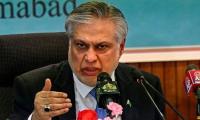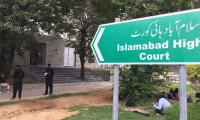The writer has a doctorate in economics and has three decades of experience in public policy and management. He represents KP in the 10th NFC.
The National Finance Commission is a great Pakistani institution and a highly robust constitutional mechanism. It is similar to other federations in place worldwide but in its decision-making mechanism is unique amongst the 26 or so federations of the world. It is set up as the keystone of the federal structure with space for the pursuit of national objectives under it.
But for most of its award-making rounds, it has remained on a low achievement equilibrium, only rarely succeeding to match resources to developmental needs. In its low equilibrium, the NFC works as a budgetary mechanism aiming at periodic settlements among competing claims. Over the course of its history, it has not necessarily achieved fiscal equalization among expenditure needs arising from differential levels of development amongst the provinces.
The NFC divides national resources in a manner that each federal unit has resources per capita in a comparable range. This mechanism does not achieve perfect equality but it does aim to equalize. Under the 7th NFC, the four provinces of Pakistan got horizontal distribution where poverty and the inverse density of population, as proxies for costs of differential service needs, were included in the distribution formula. This allowed the provinces to invest in public services.
Despite this major step forward, the [former] Federally Administered Tribal Areas of Pakistan (Fata) did not get the same treatment. They remained a federal responsibility without a formula-based fiscal allocation equivalent that was being provided to the provinces. As Pakistanis, the residents of Fata did not receive an allocation like the residents of the country. They were separate not only legally, but financially as well – and both were detrimental to the people of former Fata.
Fata has remained in planning oblivion since Pakistan’s independence. Various surveys that were conducted by the Pakistan Bureau of Statistics did not include Fata and therefore no numbers indicated the extent of underdevelopment of the tribal region. This further compounded the invisibility of the people of Fata – arguably those with the greatest need were the least, mostly not at all, surveyed.
While the provincial social indicators were time and again measured, highlighted and debated, the development of Fata had no real owner. During the 7th NFC, the expenditure on public services and development in Fata remained at an annual mean of Rs10,000 (in 2018 rupee terms), much below the levels in the four provinces, and much below the highest level of Rs19,500, perpetuating underdevelopment and poverty in the region. The total underfinancing of development of Fata in the last decade, compared with the provinces, is only a little less than a trillion rupees in real values. No wonder that Fata became a picture of poverty and conflict, with reverberations far and beyond. Essentially, Fata was understudied, underfunded and underdeveloped.
The 25th Amendment added the seven tribal districts into Khyber Pakhtunkhwa. It opened the opportunity for the tribal districts to get development and public services comparable with other areas of the country. The intent of this amendment, however, remains unrealized. While the KP government, on its own a resource-poor province, struggles to bring the tribal region into the mainstream, the resource allocations under the NFC have not materialized. Allowing Fata to be separate and unequal for decades was a national folly, the federation not coming together to fund the means required to allow the Merged Areas to catch up in development will only mean the country will be repeating the mistakes it sought to overcome with the 25th Amendment.
The seven tribal districts of KP, the erstwhile federal territories, have some of the most alarming development indicators in the world. The maternal mortality at 395 per 100,000 births, more than double the national rate, and infant mortality at 86 per 1000 live births are far worse than most places in the world. Almost half a million children remain out of school out of a population of five million residents. The literacy rate is 33 percent compared with 59 for the rest of Pakistan and female literacy at 12 compared with 47 for the rest of Pakistan. Access to drinking water in this day and age is available to 46 percent residents while the rest of Pakistan has achieved it for 91 percent of the population.
The poverty levels are high at 73 percent and the deprivation of opportunities of life is deep. These indicators require not only special attention, but urgent attention as well. Such statistics should, and must, become the binding force for a national consensus to improve the lives of the residents of the newly Merged Areas.
The merger of the erstwhile Fata with the province of Khyber Pakhtunkhwa under the 25th Amendment was a watershed moment. It offers a unique set of opportunities to address the development lag which is of a remarkable scale. A major upgrade of physical infrastructure and service delivery in the Merged Areas will be only possible through a committed and continuous flow of fiscal resources. The Tribal Decade Strategy 2020-30 approved in 2019 is the manifestation of the national commitment to the development of the Merged Areas. This commitment was voiced in the federal government’s announcement that three percent of the divisible pool under the NFC shall be reserved for development expenditures in the Merged Areas. In numbers, this demonstrates a promised allocation of Rs100 billion per annum over the 10-year time period.
For national development, it is a once-in-a-lifetime opportunity for Pakistan’s decision-makers to do the right thing. When East Germany joined West Germany in 1990, it was poor, left behind in development, with a crumbling public infrastructure. Prioritizing nation-building over short-term increases in levels of consumption, Germany dedicated 0.5 percent of GDP per annum to build up the eastern regions and achieve a true economic and social merger. Can Pakistan make a similar national decision? This is an urgent question before the 10th NFC. We should not couple a watershed constitutional amendment with a drought in funding.
It is not a matter of leisurely choice but an urgent necessity, both from the developmental as well as legal perspective. Technically, the 7th NFC has become non-compliant with the constitution as it still treats the tribal needs as outside its purview and therefore in continued oblivion. Now, the key question is if these new citizens of KP will gain equal access to public services the rest of the country, and even KP, enjoys. Legal equality will only be meaningful if the NFC prioritizes the development needs of the citizens with services that the rest of Pakistan takes for granted.
If a shortage of funds and underfinancing for the Merged Areas persists, institution-building and service delivery efforts, critical elements of the development of the region, the development gap in the erstwhile Fata will be perpetuated, not eliminated. While the merger promised to accelerate development and transform the socio-economic conditions of the Merged Areas, it is important to reiterate the original purpose of the merger and translate it through the NFC mechanism. Like the rest of the country, the residents of the Merged Areas have a rightful share in national resources..
The Merged Areas has less than two percent of urban population, no access to basic municipal services, negligible revenue-raising potential – and in this, they again compare unfavourably with the developed areas of Pakistan where large cities can generate their own finances. In the medium term, one of the main funding sources for the development of the Merged Areas will be transfers under the NFC mechanism.
The Merged Areas are a new addition of people and area, responsibilities and development needs, as well as aspirations and national priorities assigned to the government of KP, one of the four provinces. This means that within the NFC mechanism, the region needs to be treated as a continued national consensus and as a separate entity so that financial resources can be directed for their development and monitoring programmes.
This is a unique and challenging situation. The NFC mechanism has an answer to this national development priority. Now is the time to address Merged Areas financing under the NFC and complete the 25th l Amendment, not postpone it further. Pakistan rose to the occasion with the 25th Amendment to the constitution; it now needs to do the same under the NFC.
Email: cyanm777@gmail.com
Approximately one in three women worldwide has experienced either physical and/or sexual intimate partner violence ...
Prime Minister Shehbaz Sharif has laid the foundation of a Daanish school in Islamabad’s Kuri Village
Ahfaz-ur-Rahman was also an Urdu poet of considerable reputation with his poems concerning a wide range of political...
In this picture taken on April 16, 2023, people throng a market area during shopping in Lahore. — AFPCare to cast...
A representational image of a transmission tower, also known as an electricity pylon. — AFP/FileLower electricity...
Pakistan's third Governor General Ghulam Muhammad. — National Portrait Gallery website/FileAs discussed in the...







